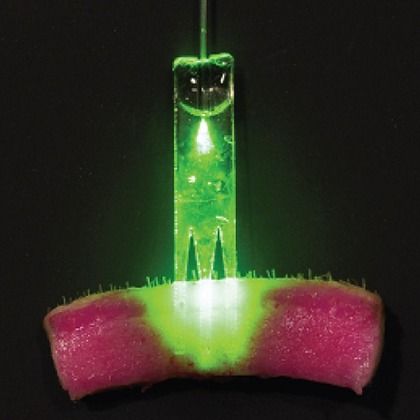Photochemical tissue bonding (PTB) is a light-based method to repair tissues and is an alternative to traditional sutures and staples used to close wounds. Unlike the latter, PTB does not cause inflammation and scarring at the repair site. PTB works by applying light-sensitive Rose Bengal dye to the exposed tissue. When the dye is exposed to green light, the dye absorbs the light, thereby causing the tissue to crosslink and form a water-tight seal. While PTB can seal incisions sans inflammation, the technique is limited by how deep the light can penetrate the tissue. Researchers from the University of St Andrews and Harvard Medical School have developed a bioabsorable optical waveguide, which can deliver light deep into tissues before being absorbed.
In a study published in Nature Communications, researchers fabricated optical waveguides from a variety of polymers, but ultimately tested the degradation times of the polymers PVP and PLGA (50:50) in vivo. They inserted 1 × 5 mm x 500 µm pieces of bulk polymer subcutaneously in mice and examined the implant at different time points. The PVP waveguide dissolved within one hour of implantation, whereas the PLGA polymer began to lose shape after 17 days, illustrating that researchers can tune the degradation time (ranging from hours to days) of the optical waveguide for a specific application.
After establishing the biodegradability of the polymer waveguides, the team showed how the waveguides could extend the penetration depth in PTB. Light was coupled to the device via pigtail fiber, which was trimmed off after light was applied, thus leaving only the bioabsorable polymer within the wound. Immediately after a pig was killed, they made a “full-thickness incision” (1 cm) on the dorsal skin and applied Rose Bengal dye. In the control, they applied 532-nm light (1 W) for 15 minutes at the surface of the wound. In waveguide assisted PTB, they inserted the polymer waveguide and applied light through the waveguide, effectively increasing the penetration depth of the light. The shear tensile strength of the control PTB was 0.33 kPa compared to 1.94 kPa in the waveguide assisted PTB, illustrating that the optical waveguide enabled tissue crosslinking and wound healing at greater depths.

 Photochemical tissue bonding (PTB) is a light-based method to repair tissues and is an alternative to traditional sutures and staples used to close wounds. Unlike the latter, PTB does not cause inflammation and scarring at the repair site. PTB works by applying light-sensitive Rose Bengal dye to the exposed tissue. When the dye is exposed to green light, the dye absorbs the light, thereby causing the tissue to crosslink and form a water-tight seal. While PTB can seal incisions sans inflammation, the technique is limited by how deep the light can penetrate the tissue. Researchers from the University of St Andrews and Harvard Medical School have developed a bioabsorable optical waveguide, which can deliver light deep into tissues before being absorbed.
Photochemical tissue bonding (PTB) is a light-based method to repair tissues and is an alternative to traditional sutures and staples used to close wounds. Unlike the latter, PTB does not cause inflammation and scarring at the repair site. PTB works by applying light-sensitive Rose Bengal dye to the exposed tissue. When the dye is exposed to green light, the dye absorbs the light, thereby causing the tissue to crosslink and form a water-tight seal. While PTB can seal incisions sans inflammation, the technique is limited by how deep the light can penetrate the tissue. Researchers from the University of St Andrews and Harvard Medical School have developed a bioabsorable optical waveguide, which can deliver light deep into tissues before being absorbed.